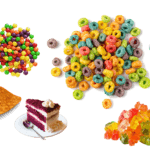The conversation surrounding artificial dyes in the food industry has intensified in recent years, with growing scrutiny from both consumers and regulatory bodies.
Today, Kraft Heinz announced a monumental decision to eliminate all artificial dyes from all U.S. products by 2027 (“%Sveltekit.title%,” 2025).
This decision is part of a broader industry trend driven by shifting consumer preferences and regulatory actions addressing health concerns related to synthetic food coloring.
This blog post examines the implications of Kraft Heinz’s decision, its significance in the food industry, and its impact on both consumers and competitors.
The Growing Scrutiny of Artificial Dyes
For years, the food industry has utilized artificial dyes to enhance the visual appeal of products.
Colors such as Red 40, Yellow 5, and Blue 1 enhance the vibrancy of foods and beverages, especially those marketed toward children. For more on the toxicity of artificial food colorings, please read: https://grosseating.com/the-use-of-artificial-colors-in-our-food-supply/
However, multiple studies and consumer advocacy groups have consistently raised concerns about their safety.
Current research highlights potential links between synthetic food dyes and various health risks, including behavioral issues in children, allergic reactions, and even carcinogenicity in some dyes. These concerns have sparked increasing regulatory scrutiny.
For instance, the U.S. Food and Drug Administration (FDA) banned Red Dye No. 3 in January 2025 and announced plans to phase out petroleum-based synthetic dyes over the next few years.
Secretary Robert F. Kennedy Jr. and several state governments have further amplified the spotlight on these dyes, pressuring manufacturers to reformulate their products.
With bans and stricter regulations taking hold in states like California and Virginia, it’s good to see that the industry landscape is undergoing rapid evolution.
Kraft Heinz’s Decision to Adapt
Kraft Heinz, a household name behind iconic products such as Kraft Mac & Cheese, Heinz ketchup, and Jell-O, has long faced pressure to shift toward healthier ingredients.
The company’s decision to eliminate artificial food dyes by 2027 represents a proactive step to meet consumer expectations while aligning with regulatory requirements.
Pedro Navio, Kraft Heinz’s North America president, emphasized, “The vast majority of our products already use natural or no colors. We’re on a mission to eliminate synthetic dyes completely, ensuring our food aligns with changing consumer needs.”
Key Highlights of the Announcement
- Immediate Halt on New Products with Artificial Dyes: Kraft Heinz will no longer launch any new products containing synthetic food dyes in the United States.
- Phasing Out by 2027: The company aims to reformulate its remaining products to remove or replace artificial dyes with natural alternatives.
- Exploring Innovation: For products heavily reliant on vibrant colors, Kraft Heinz plans to reinvent them with innovative natural coloring methods if no direct alternatives exist.
- Collaboration with Licensing Partners: The company is also working with brand licensees to adopt these changes across its extended product portfolio.
What Does This Mean for Competitors?
Kraft Heinz’s bold step places additional pressure on other food industry players.
Major competitors, such as General Mills, Kellogg’s, and Tyson Foods, have already begun reformulating their offerings, but Kraft Heinz’s timeline may set a new benchmark moving forward.
Other companies, such as Sam’s Club (owned by Walmart), have committed to removing synthetic additives, including artificial colors, from their private-label brands by 2025.
Kraft Heinz’s 2027 goal will likely give these initiatives ample spotlight and encourage similar commitments from rival brands.
Why This Matters to Consumers
Healthier Product Options
For consumers, the removal of artificial dyes ensures access to cleaner, safer food options.
Historically, some artificial dyes have been linked to hyperactivity in children and potential long-term health risks. Natural colorings may mitigate these concerns.
Greater Transparency
Kraft Heinz’s move signals a willingness to listen to its customer base and invest in transparency. With more consumers scrutinizing food labels and demanding better ingredients, this decision strengthens the company’s reputation as one that prioritizes public health.
A Shift Toward Cleaner Labeling
This announcement aligns with the broader “clean label” movement, which is gaining traction across the food industry. Customers seeking minimally processed and naturally sourced ingredients are now more likely to perceive Kraft Heinz as a brand that values their well-being.
Challenges Ahead
While Kraft Heinz’s commitment is commendable, the process of replacing synthetic dyes may face hurdles.
- Cost Implications: Reformulating products and sourcing natural alternatives can often increase production costs, which may impact pricing.
- Preserving Appearance: Synthetic dyes offer consistency and brightness that some natural options struggle to replicate. Developing stable, vibrant alternatives may require significant innovation.
- Supply Chain Adjustments: The company must secure reliable suppliers for natural colorings and adapt its manufacturing processes to accommodate these changes.
Despite these challenges, Kraft Heinz’s market influence positions it as a leader capable of setting industry-wide trends.
A Step Forward for the Food Industry
The food sector is expected to undergo significant changes as a result of Kraft Heinz’s strategy to phase out artificial coloring.
In addition to addressing the escalating health issues, it also acts as a model for creativity and accountability in the food manufacturing industry.
Now, rivals will also strive to fulfill the same standards or risk lagging behind.
The shift to natural colors from synthetic dyes marks a significant change in the industry.
The future of food production appears more promising than ever as producers place a greater emphasis on producing safer and cleaner products.




